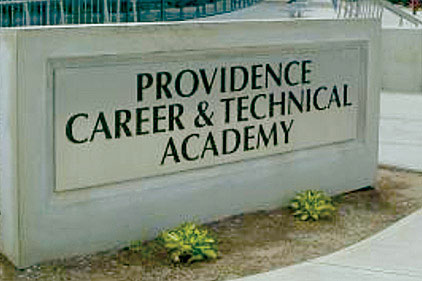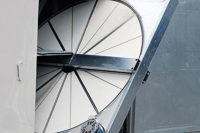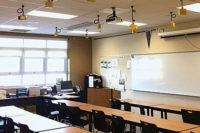PCTA opened its doors to its first class of students on September 2, 2009, after 212,000 sq ft of new construction plus 72,000 sq ft of renovation in the previously existing Hanley classroom building. Now, one of New England’s premiere technical high schools, PCTA features high-tech classrooms, equipment, labs, media centers, athletic facilities, and other amenities for a high-quality education. The school offers nine vocational programs including automotive technology, construction technology, cosmetology, culinary arts, and HVAC, in addition to a required college-prep curriculum of math, science, and English.
The school building was designed to satisfy the full requirements of NE-CHPS, whose mission is to promote school environments that are not only energy- and resource-efficient, but also healthy, comfortable, and well lit. Oftentimes, highly efficient buildings mean premium costs. Because PCTA, like many public schools, was no stranger to budget constraints, designers had to limit initial costs in creative ways.
A CREATIVE SOLUTION
A major design directive to save on construction costs led PCTA to install a dual–temperature, two-pipe HVAC system. In contrast to the more common (and more expensive) four-pipe system where heating and cooling are available at any time, two-pipe systems cannot engage cooling coils to reduce humidity on cool, damp days while in the heating mode. The solution to this dilemma was to install Airxchange energy recovery wheels containing a silica-gel desiccant for moisture transfer. By rotating between building exhaust and outdoor intake air streams, the wheels remove moisture from outdoor air on damp days and reject it into the exhaust air stream to keep indoor relative humidity at a comfortable level.
Engineer Brian Zigmond, a principal of StudioJAED, stated, “Since the school utilizes a two-pipe system, we needed a way to mitigate humidity issues typical to the area during ‘shoulder’ seasons. Rejecting as much humidity as possible back to the outdoors with an energy recovery wheel is the most practical solution available. We’ve had success with implementing energy recovery wheels in new and existing schools. Given school budget constraints, installing energy recovery wheels to save on up-front and operating costs is a no-brainer.”
REDUCING LOAD EARNS AN A PLUS
StudioJAED also realized during the planning phase that energy recovery would have to be incorporated into the design of PCTA’s HVAC system if the 40% energy reduction goal were to be achieved. The team chose to utilize a combination of AHUs and standalone energy recovery ventilators (ERVs) with Airxchange energy recovery wheels to provide outdoor air to PCTA’s new and retrofitted classrooms, labs, auditorium, and media center.
The Airxchange wheels help to condition 45,215 cfm of outdoor air by continuously recycling the heating or cooling energy (depending on the season) from the exhaust airstream. On peak design days, the energy recovery wheels reduce the outdoor air load by as much as 80%.
The ability of Airxchange wheels to save on energy is evident at PCTA, especially during the heating season. In the first winter of operation, David Gaudet, PCTA facility manager, kept his eye on the boilers to ensure they were able to handle the load. He was surprised at how infrequently the boilers actually started up. “I kept waiting for the boilers to fire on cold days. But the energy recovery wheels were able to heat the outdoor air enough to significantly reduce boiler operation. The wheels keep the supply air in a nice comfortable zone where frequent additional heating is not required,” he said.
With rising fuel prices, the conditioning provided by the Airxchange wheels to reduce boiler operation generates tremendous cost savings. PCTA HVAC technician Brian Polak added that he was able to shut down the entire boiler system for a few hours to perform emergency work during one of the coldest days of the winter without the system being negatively affected. The ERV/AHU system with Airxchange wheels keeps the school in the “comfort zone.”
THE RESULTS SPEAK FOR THEMSELVES
PCTA operates in the 43 kBtu/sq ft range, which is about 40% lower than the national average for all high schools, not just technical schools. The improved efficiency yields huge savings on utility bills. Through their reduction in outdoor air load, Airxchange energy recovery wheels account for an estimated $28,000 in annual utility savings. Because of PCTA’s Northeast location, the majority of the savings are realized in the heating months, but because Airxchange wheels exchange moisture and maintain superior IAQ, they benefit the school year-round.






